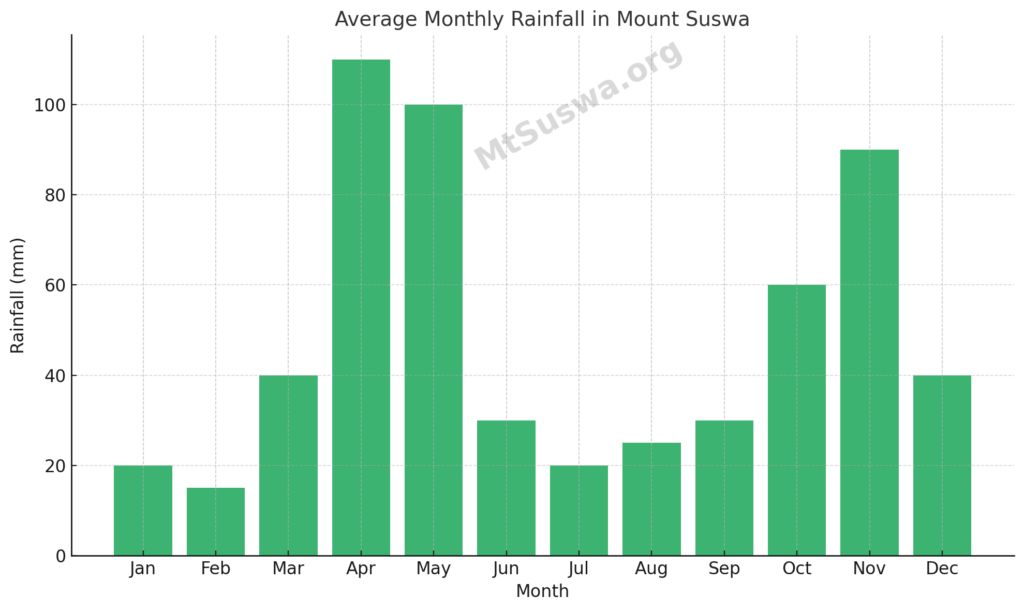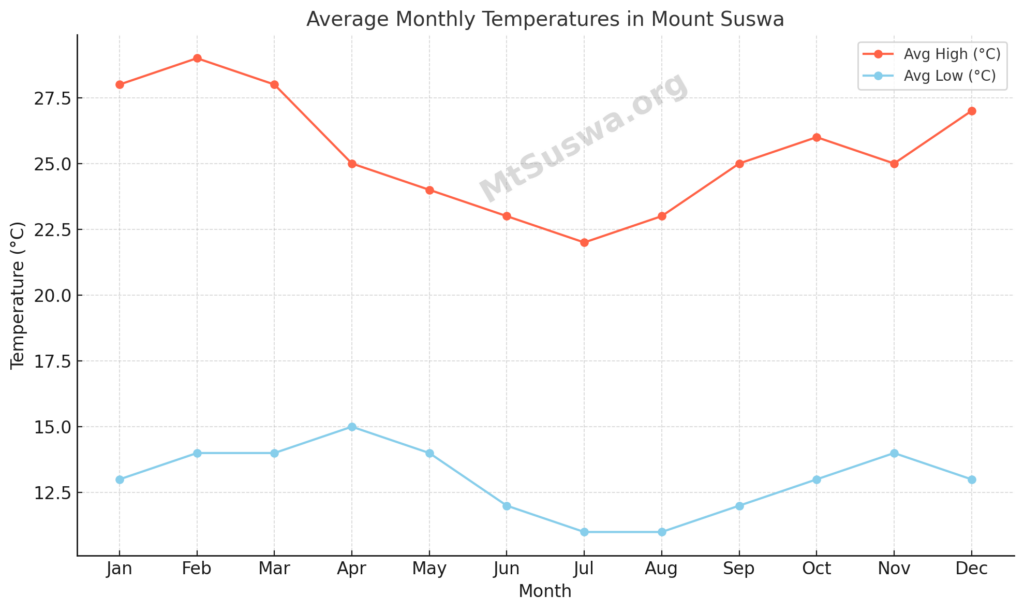Mount Suswa is a year-round destination, but your experience will vary depending on weather, accessibility, photography conditions, and local activity. Situated in Kenya’s southern Rift Valley at around 2,356 meters above sea level, Suswa experiences semi-arid highland weather — hot during the day, cool at night, and prone to seasonal rains.

🗓️ Quick Overview: Best Time by Season
| Season | Months | Best For | Notes |
|---|---|---|---|
| Dry Season | Jan–Mar, Jun–Oct | Hiking, camping, stargazing, photography | Ideal for all activities |
| Short Rains | Nov | Green landscapes, wildlife, fewer visitors | Some slippery trails, but still accessible |
| Long Rains | Apr–May | Lush terrain, steam vent contrast | Not ideal — muddy roads, cave access limited |
🌞 January to March: Hot, Dry & Perfect for Hiking
Recommended
- Clear skies, warm days, and minimal rain
- Excellent for crater rim hikes, cave exploration, and sunrises
- Roads are in good condition (by Suswa standards)
- Nights can get chilly — bring warm layers
🎯 Ideal for photographers, first-time campers, and those looking for peak crater views
🌿 April to May: Long Rains & Limited Accessibility
Not Recommended (for most)
- Heavy rains often flood the off-road track from Suswa town
- Trails become muddy and slippery, especially around caves
- Camping is challenging — tents and gear must be waterproof
- Fewer visitors = solitude, but higher risk of getting stuck
🌧️ Only attempt during this season if you’re experienced, well-equipped, and with a local guide
⛅ June to October: Cool, Crisp, and Ideal for Exploration
Highly Recommended
- Dry, cool temperatures perfect for camping and hiking
- Vegetation remains green in early June; drier by August
- Best time for long hikes, multi-day adventures, and trail running
- Clear skies = unbelievable stargazing
🔥 Campfires feel cozier, and crater nights are refreshingly cool — not cold

🌦️ November: Short Rains & Dramatic Landscapes
Moderately Recommended
- Light, scattered rains make the landscape greener
- Steam vents more visible in the morning mist
- Some parts of the trail may be muddy
- Fewer crowds = peaceful hikes and photo ops
💡 Go with a guide, wear boots with good grip, and carry a rain jacket
📸 Best Time for Specific Activities
| Activity | Best Time | Why |
|---|---|---|
| Crater Rim Hike | Jan–Mar, Jun–Oct | Dry trails, clear views, comfortable temperatures |
| Lava Cave Exploration | Jan–Mar, Jun–Oct | Safe footing, caves less humid or flooded |
| Camping | Jan–Mar, Jun–Oct | Cool nights, safe terrain, dry firewood |
| Photography | Jan–Mar, Nov, Jun–Jul | Sunrise/sunset skies, mist over vents, golden light |
| Cultural Visits | Year-round | Always accessible — dry season preferred |
| Wildlife Viewing | Jun–Oct, Nov | Baboons, birds of prey, hyenas more active in cool |
| Mountain Biking | Jan–Mar, Jun–Aug | Dry plains, clear trails, less thorn overgrowth |
🧥 Weather Breakdown by Month
| Month | Avg. High (°C) | Avg. Rainfall (mm) | General Conditions |
|---|---|---|---|
| January | 27–30 | 10–20 | Hot, dry, clear skies |
| February | 28–31 | 10–15 | Peak dry season, ideal hikes |
| March | 26–30 | 20–50 | Still dry early, rains begin late month |
| April | 24–27 | 100+ | Wet, muddy, access tricky |
| May | 22–26 | 80–100 | Lush but muddy, rains taper off |
| June | 23–27 | 20–30 | Dry, green, cool nights |
| July | 22–26 | 10–20 | Dry, perfect for camping |
| August | 23–27 | 10–30 | Warm days, great visibility |
| September | 25–28 | 10–40 | Warm and dry, low tourist traffic |
| October | 26–29 | 30–60 | Mixed weather, good for experienced hikers |
| November | 24–27 | 80–100 | Short rains, dramatic scenery |
| December | 26–30 | 40–60 | Variable, early dry season |
🧭 Final Verdict: When Should You Go?
| If you want… | Go in… |
|---|---|
| Best overall conditions | January, February, June–August |
| Fewer crowds but good views | September, November |
| The greenest scenery (with effort) | November, May |
| Guaranteed dry trails and clear skies | July, August |
| Cultural immersion and cooler camping | June–October |
| Budget travel and peace | Off-season (May, Nov) |
✅ Pro Tips for Choosing Your Dates
- 📆 Avoid long rains (Apr–May) unless you’re up for a challenge
- 🌕 Plan around the moon: New moon = best stargazing
- 👣 Book guides in advance during high season (Jan–Mar, Jun–Aug)
- 🛻 Only travel with a 4×4 year-round — roads are rough even when dry
- ⛺ Check gear before rainy months — waterproof everything
🌟 Final Word
Mount Suswa is beautiful in any season — but timing your visit right makes all the difference between a good hike and a life-changing experience. Whether you’re chasing sunrises, exploring lava caves, or camping under the stars, the dry seasons (January–March & June–October) offer the safest and most rewarding window to explore this hidden volcanic gem.
